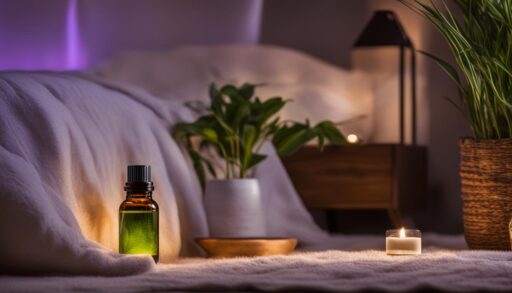Are you looking for a natural remedy to help you relax and get a better night’s sleep? Look no further than essential oils. These oils, extracted from plants, have been used for centuries to promote relaxation and improve sleep. With the power of aromatherapy, essential oils can help you unwind and drift off to dreamland.
Key Takeaways:
- Essential oils can promote relaxation and better sleep.
- Aromatherapy is a popular method to use essential oils for sleep improvement.
- Lavender, chamomile, bergamot, peppermint, cedarwood, sandalwood, and marjoram are commonly used essential oils for sleep.
- These oils have sedative and calming effects, reduce anxiety and stress, alleviate pain, and improve sleep quality.
- It’s important to consider the pros and cons, as essential oils may not work for everyone and could cause allergic reactions.
Lavender: A Versatile Essential Oil for Sleep Improvement
Lavender essential oil is a popular choice for those seeking to improve their sleep quality. It offers a range of benefits, including anxiety reduction, pain relief, and insomnia management. The sedative and calming effects of lavender oil make it a powerful tool for promoting relaxation and better sleep.
Studies have shown that inhaling lavender oil or applying it topically can lead to improved sleep quality and duration, particularly in individuals with insomnia. In addition to its sleep-inducing properties, lavender oil has also been found to alleviate pain, reduce headaches, and promote wound healing.
You can easily incorporate lavender essential oil into your bedtime routine by inhaling it directly from the bottle, using a diffuser, or diluting it with a carrier oil and applying it to your skin. It can also be combined with other essential oils to create a personalized blend that suits your needs.
Whether you’re struggling with anxiety, insomnia, or simply want to enhance your sleep quality, lavender essential oil can be a valuable addition to your nighttime routine.

Testimonials
“I’ve been using lavender essential oil before bed for the past month, and I’ve noticed a significant improvement in my sleep quality. I fall asleep faster and wake up feeling more refreshed. It has been a game-changer for me!” – Emily, Sleep Enthusiast
“After reading about the benefits of lavender oil for sleep, I decided to give it a try. I’ve struggled with insomnia for years, but since incorporating lavender oil into my nighttime routine, I’ve experienced a noticeable improvement in both the quantity and quality of my sleep.” – Mark, Insomnia Sufferer
Chamomile and Bergamot: Calming Essential Oils for Sleep Support
When it comes to improving sleep quality and promoting relaxation, chamomile and bergamot essential oils offer impressive benefits. Chamomile essential oil, derived from the chamomile flower, has long been recognized for its calming properties and anxiety relief. It can also aid in reducing pain and promoting wound healing, making it a versatile oil for overall well-being.
Studies have shown that inhaling chamomile oil can effectively reduce anxiety in pregnant women and enhance sleep quality in patients staying in an intensive care unit. The soothing aroma of chamomile can create a sense of tranquility, helping you unwind and prepare for a restful night’s sleep.
Bergamot essential oil, extracted from the peel of the bergamot fruit, offers similar benefits. This oil has been found to lower blood pressure, alleviate mental health issues, and provide a calming effect. Aromatherapy mixtures containing bergamot, lavender, and ylang-ylang have shown significant improvements in sleep quality for individuals with heart problems.
Both chamomile and bergamot essential oils can be used individually or in combination with other oils for sleep support. Whether inhaled or applied topically, these oils can help create a peaceful environment conducive to better sleep. It’s important to note that while essential oils can be highly beneficial, individual experiences may vary, and allergic reactions can occur. It’s always recommended to perform a patch test before using any new essential oil and consult with a healthcare professional if you have any underlying health conditions.
Overall, chamomile and bergamot essential oils offer natural remedies for anxiety relief, pain reduction, and sleep quality improvement. By incorporating these calming oils into your bedtime routine, you can create a soothing atmosphere that promotes relaxation and a restful night’s sleep.
Peppermint and Cedarwood: Essential Oils for Pain Management and Relaxation
Peppermint essential oil and cedarwood essential oil are both highly regarded for their therapeutic properties, providing relief from pain and promoting relaxation. These essential oils can be valuable additions to your bedtime routine, helping to improve the quality of your sleep.
Peppermint essential oil contains menthol, which has analgesic and anti-inflammatory properties. When applied topically or inhaled, peppermint oil may help alleviate headaches, muscle pain, and discomfort. Its refreshing aroma can also help reduce stress and anxiety, creating a calming environment that is conducive to a restful sleep.
Cedarwood essential oil, with its warm and woody scent, has been used for centuries for its relaxing and grounding effects. It has sedative properties that can help promote deep relaxation and relieve tension. Cedarwood oil may also aid in reducing stress and anxiety, which can contribute to improved sleep quality.
When using peppermint or cedarwood essential oil for sleep, it’s important to dilute them properly in a carrier oil, such as coconut oil or jojoba oil, before applying them topically. This will help prevent skin irritation and ensure safe usage. Alternatively, you can add a few drops of these essential oils to a diffuser and inhale the calming aroma as you prepare for bed.
| Peppermint Essential Oil | Cedarwood Essential Oil |
|---|---|
| Relieves headaches and muscle pain | Provides deep relaxation |
| Reduces stress and anxiety | Promotes grounding and tranquility |
| Refreshes and invigorates the senses | Enhances sleep quality |
“Peppermint and cedarwood essential oils offer a natural and holistic approach to pain management and relaxation. Their therapeutic properties can contribute to a more peaceful and restorative sleep.”
It’s important to note that essential oils may affect individuals differently, and some people may be more sensitive to their effects. Before using peppermint or cedarwood essential oil, it is recommended to perform a patch test on a small area of your skin to check for any adverse reactions. If you have any underlying health conditions or are taking medications, it’s always best to consult with a healthcare professional before incorporating essential oils into your sleep routine.
Sandalwood and Marjoram: Essential Oils for Holistic Healing and Sleep Support
Looking to enhance your sleep quality and promote holistic healing? Consider incorporating sandalwood and marjoram essential oils into your bedtime routine. These oils offer a range of benefits, from mood improvement to stress reduction, making them excellent choices for enhancing your sleep experience.
Sandalwood essential oil, known for its calming properties, can help improve your mood and reduce stress and anxiety. With its woody aroma, sandalwood creates a soothing environment that sets the stage for a restful night’s sleep. Although research specifically on sandalwood’s impact on sleep is limited, a study found that an essential oil blend containing sandalwood significantly improved sleep quality in individuals living with cancer.
Marjoram essential oil, on the other hand, offers stress and depression-alleviating capabilities along with pain-relieving properties. If you’re struggling with stress or anxiety that affects your sleep, marjoram can be a helpful addition to your nighttime routine. In a study on nurses working night shifts, an aromatherapy massage oil containing sweet marjoram essential oil significantly improved sleep quality when compared to a control group.
To incorporate sandalwood or marjoram essential oils into your sleep routine, you can diffuse them in your bedroom using an essential oil diffuser. Alternatively, you can mix a few drops with a carrier oil and apply the mixture to your skin before bed. Whichever method you choose, these oils can provide a natural and pleasant way to enhance your sleep quality and promote holistic healing.



















